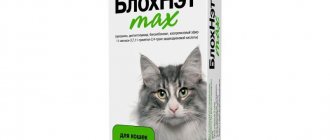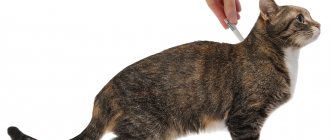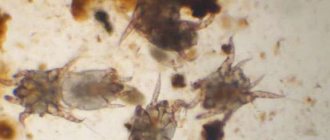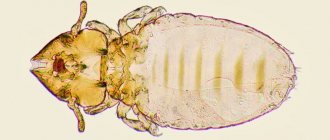Tips on how to recognize and treat ear mites in cats at home. And what is the best prevention of this disease?
Ear mites in cats are the causative agent of such a common parasitic disease as ear scabies (otodectosis). Infected cats experience severe itching and discomfort. In the absence of proper therapy, the disease can progress and spread to the meninges. This is dangerous because animals may experience nervous seizures. In advanced cases, deafness and death are possible.
Where can you get infected with ear mites, how to make a correct diagnosis, what is included in the treatment regimen and is it possible to protect your pets from this parasite - look for answers to these questions in our material.
What is an ear mite
Ear mites are microscopic (0.2-0.7 mm) white-yellow ectoparasites (Otodectes cynotis). They are localized in the inner ear of cats and feed on lymph (ichor) and tissue fluid. The moist and warm environment inside the ear is ideal for the growth and reproduction of these parasites.
Risk group
According to veterinarians, every second cat has had or has ear mites. But not all animals suffer from otodectosis. In order for a colony of mites to grow to a critical size that causes ear scabies, favorable conditions are necessary.
At risk:
- kittens that have not undergone antiparasitic treatment;
- young animals up to 1 year;
- adult cats with weakened immune systems;
- cats that go outside;
- animals living together in cat hotels, shelters;
- sick and malnourished animals.
Important!
Stray cats often suffer from ear scabies, so you should try to protect your pets from contact with such individuals.
Routes of infection
Even the cleanest pets can become infected with ear mites. There are several ways to catch a tick or its larva:
- Contact. Cats become infected through contact with sick animals.
- Domestic. Through care items (bedding, toys, combs).
- Parasitic. Fleas can become sources of infection.
- Unsanitary. Ticks can be brought from the street or entrance on shoes or clothes.
Small kittens that have not yet developed immunity can become infected from their mother during the nursing period.
Can you see ear mites?
Without special optical instruments, it is very difficult to see this tiny arthropod creature.
At home, you can try to spot parasites like this:
- take a black/dark piece of paper and place it under the table lamp;
- then use a cotton swab to carefully collect the contents of the cat’s ear;
- make a dab on paper with a cotton swab;
- take a magnifying glass and try to examine the smear - if there is an infection, you will see movement.
This way you can see the ear mites. But this method is only suitable for severe infections. If there are few parasites, they may not be visible.
Symptoms of ear mange in cats
Ear mites in cats multiply quite quickly, so if you notice at least one of the following signs, take action immediately:
- The animal constantly shakes its head or tilts it to one side.
- The cat becomes restless and sleeps poorly.
- The animal is trying to get rid of severe itching by scratching its ears.
- Bloody scratches appear on the ears.
- Earwax discharge from the ears is profuse.
- Mite waste products, reminiscent of ground coffee crumbs, accumulate on the inner surface of the ear.
- The animal hears worse.
- Discharge from the ears acquires an unpleasant odor.
- Your cat may have a fever.
The disease has many complications: fungal infections, secondary infection from scratching, deafness, damage to the hearing and nervous system. Don't put off visiting the veterinarian.
Diagnostics
The symptoms of ear mites in cats are very similar to those of other ear diseases. Therefore, under no circumstances begin to treat otodectosis without making a diagnosis at a veterinary clinic.
Diagnostic measures:
- collecting anamnesis and studying the clinical picture;
- otoscopy – examination of an animal with an otoscope;
- microscopic examination of sulfur - the doctor examines scrapings from the auricle under a microscope;
- cytological examination to detect accompanying microflora (fungi, bacteria);
- bacterial culture.
Causes of otodectosis
The main cause of ear mites in cats is infection. This can happen in the following ways:
- Ear mites in cats can occur through direct contact with infected animals. This is the most common cause.
- Through people who have been in contact with infected animals. The owner himself, without knowing it, can become a source of infection. But do not be alarmed; this parasite is not dangerous to humans.
- Through hygiene and care products.
- Fleas can also carry ticks.
Treatment of ear mites in cats
Treatment is prescribed only after all clinical studies have been completed and a final diagnosis has been made.
Having received the veterinarian’s prescription, strictly adhere to the dosage of the medication and the regularity of medical procedures. Remember that you should not stop treatment immediately after the symptoms of the disease disappear, as this may lead to re-infection.
Important!
Ear mites in cats with intensive treatment can spread from the ears to your pet's body, so examine your cat regularly and be attentive to its behavior. In order to treat the animal from parasites, the doctor may prescribe antiparasitic drops on the withers (Leopard, Prazicide) - this will help destroy the individuals that have left the ear.
Treatment in the clinic
The animal can be left at the clinic if the disease has affected the vestibular apparatus of the ear. In this case, the animal needs surgery. In all other cases, treatment of otodectosis in cats is carried out at home. You need to be patient - it may take from 28 days to several months to completely get rid of ear scabies.
Treatment at home
The process of treating a cat for ear mites is multi-stage and consists of several mandatory steps:
- Relieving inflammation, itching and pain - antiseptics, antihistamines.
- Cleaning the ear - saline solution, hygienic lotions for the ears.
- Acaricidal drugs - instilled into the ear at intervals of 5 days.
- Preventive antiparasitic treatment – preparations for fleas and ticks.
In some cases, antibiotic therapy may be prescribed. The doctor prescribes the treatment and regimen based on the degree of invasion, the age and condition of the animal, and the stage of the disease. All stages are important in the treatment regimen. Their implementation is necessary to completely get rid of ectoparasites and prevent re-infection of the cat.
Remember
Otodectosis is a highly contagious disease, therefore, in parallel with the implementation of therapeutic measures, it is necessary to disinfect the animal’s habitats. It is also necessary to carry out antiparasitic treatment of all animals in contact with each other.
How to properly clean a cat's ear
The ear cleansing procedure is carried out very carefully, without going deep, so as not to injure the eardrum. This is best done with a damp cloth. You need to drop 1-2 drops of warm saline into each sore ear and massage the base for 2-5 minutes. Instead of saline solution, you can use a neutral herbal lotion (“Rosinka”, “Bars”). This will help the contents come out. What comes out needs to be wiped off with a napkin.
Important!
It is not allowed to clean your ears with hydrogen peroxide or other aggressive agents!
Read more about how to clean your cat's ears.
Preparations for the treatment of otodectosis in cats
Stronghold
American-made systemic multifunctional drug. Manufacturer: Zoetis (Pfizer). Penetrates the cat's blood and destroys external and internal parasites. The drug has minimal toxicity.
How to use:
In the treatment of otodectosis, it is used once. To do this, you need to part the fur and squeeze out the entire contents of the pipette onto dry skin along the line of the spine. In advanced cases, it is possible to re-treat the animal after 30 days.
Contraindications:
- pregnancy;
- lactation period;
- age up to 1.5 months.
Price: 3 pipettes – 1200-1600 rub./190-550 UAH.
Frontline Spot On
A French-made contact preparation based on fipronil is an effective remedy for otodecosis. The active ingredient of the drug acts directly on ear mites and their larvae, so it must be instilled directly into the ears.
How to use:
To get rid of ear mites, instill 4-6 drops of the drug into each ear once. After instillation, the pet’s ear should be folded in half and gently massaged. The remains of the drug are applied to the cat’s withers.
Contraindications:
- age up to 2 months;
- Do not use on sick cats or cats during the recovery period.
Price: 1 pipette – 340-400 rub./170-180 UAH.
Aurikan
Veterinary ear drops for the treatment of otodectosis in cats and dogs. Effective in cases complicated by bacterial infection.
How to use:
The drug is instilled 5 drops into each ear. The procedure is repeated once a day for 7 days. After this, proceed to the following regimen: 5 drops in each ear 2 times a week for 3 weeks.
Contraindications:
- individual intolerance.
Price: bottle (20 ml.) – 440-500 rub./200-220 UAH.
Top 15 drugs for the treatment of ear diseases in cats and dogs.
Nowadays, quite a lot of drugs have appeared on the Russian market of veterinary drugs for the treatment of diseases such as otitis media (both fungal and bacterial) and ear mite parasitism.
In this review we will consider and compare the presented drugs.
Of course, before treating the problem, it is necessary for the veterinarian to make a diagnosis, identify the nature of the disease and, based on this, select a drug.
Now many manufacturers have switched to producing complex preparations that act on both fungi, bacteria and mites.
So, the presented drugs:
- Anandin, Anandin-plus
- Aurikan
- Bars, Bars Forte
- Dana
- Decor-2
- Oritsin
- Otibiovin
- Otoferonol, Otoferonol Plus, Otoferonol Gold
- Surolan
- Tsipam
- Amitrazine
- Otibiovet
- Aurizon
- Otonazole
- Rolf club
The products must be used strictly according to the instructions, observing the number of treatments and duration of treatment. Almost all drops cannot be used if the eardrum is damaged, so it is better not to neglect an examination by a veterinarian before treatment. As a rule, complex preparations also contain substances that reduce itching and inflammation. Drops such as Surolan, Otobiovet, Aurizon, Aurikan, Otobtiovin have proven themselves especially well. A big advantage of the drugs Surolan and Oricin is the possibility of using them for pregnant and lactating cats and dogs. Surolan almost does not cause skin irritation, unlike drugs such as Bars, Otoferonol, Decor, Amitrazine, which quite often cause local allergic reactions. However, the cost of the same Surolan and Oritsin is several times higher than the cost of competitors. It is worth remembering that otitis media can be caused by both bacteria, fungi, and mites (otodectosis). Therefore, an incorrectly selected drug may not help in treatment. For example, Bars, Dana, Decor-2, Tsipam, Amitrazine, Rolf Club act on ticks and other ectoparasites, but will not help with fungal and bacterial otitis. Conversely, the action of Otobiovin, Otibiovet, Otonazol is directed exclusively against bacteria and fungi. The table below will help you decide on the choice of drug based on the cause of the disease.
| Drug name | Company manufacturer | Indications for use | Notes |
| Anandin, Anandin-plus | Mediter, Russia | Anandin-bacterial otitis (mainly gram-positive bacteria) Anandin Plus – bacterial otitis, otodectosis. | *Mildly toxic to cats and dogs. *Does not apply to damaged eardrums |
| Aurikan | Micro-plus, Russia | bacterial otitis, otodectosis. | Not suitable for damaged eardrums |
| Bars, Bars Forte | Agrovetzaschita, Russia | Bars Forte - fungal and bacterial otitis Leopard - otodectosis. | *Do not use with drugs containing organophosphorus compounds. *Does not apply to damaged eardrums |
| Dana | Api-San, Russia | demodicosis, notoedrosis, sarcoptic mange, otodecosis | *Do not use in case of illness, pregnancy and lactation, in puppies under 12 weeks and weighing less than 2 kg. *Does not apply to damaged eardrums |
| Decor-2 | Veterinary Center, Russia | otodectosis | May cause irritation and burning |
| Oritsin | Maramed, Germany | Fungal and bacterial otitis, otodectosis. | *Can be used during pregnancy and lactation of animals *Does not apply to damaged eardrums *Do not use with other insectoacaricidal drugs |
| Otibiovin | Bioveta, Czech Republic | Fungal and bacterial otitis | Not suitable for damaged eardrums |
| Otoferonol, Otoferonol Plus, Otoferonol Gold | Otoferonol Gold – bacterial otitis, otodectosis. Otoferonol – bacterial otitis. Otoferonol Plus - bacterial otitis, otodectosis | *Does not apply to damaged eardrums. *Possible burning and irritation. | |
| Surolan | Janssen Animal Health, Belgium | Fungal and bacterial otitis, otodectosis, relieves itching and inflammation. | *Does not apply to damaged eardrums. *Can be used during pregnancy and lactation. |
| Tsipam | Tsamaks, Russia | demodecosis, notoedrosis, sarcoptic mange, otodecosis, otitis, ringworm, lice, fleas, lice, | Do not use in case of illness, pregnancy or lactation, in puppies under 6 weeks of age. |
| Amitrazine | Polisan, Russia | otodectosis (ear mites), notoedrosis and demodicosis | *Do not use during pregnancy *May cause irritation and burning. |
| Otibiovet | Vetfarm, Belarus | Fungal and bacterial otitis | An opened bottle is stored for 12 days. |
| Aurizon | Vetokinol S.A. (Vetoquinol SA) , France | Fungal and bacterial otitis, ear scabies. | *Does not apply to damaged eardrums. *Do not use during pregnancy and lactation. |
| Otonazole | KRKA, Slovenia | Fungal and bacterial otitis | The duration of use of the drug is no more than 15 days. |
| Rolf club | Ecoprom, Russia | otodectosis, sarcoptic mange, notoedorosis | *Do not use during illness, pregnancy and lactation, in puppies up to 8 weeks, and also simultaneously with other insectoacaricidal agents. |
Prevention
As a preventive measure, do not forget about the hygiene of your cat and regularly inspect and clean the ears using specialized hygienic drops "Bars" and do not forget about the quarterly treatment of the animal against fleas and ticks with drugs: Frontline, Advantix, etc.
In addition, do not neglect regular cleaning using insecticidal agents of all areas where the animal is. Keep the bedding and all cat care items clean, and make it a rule to never use other people's items.











